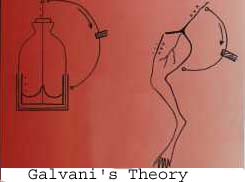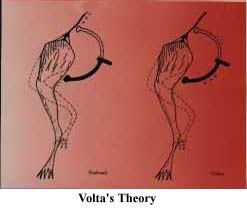GALVANI'S EXPERIMENTS WITH FROGS' LEGS
Animal Electricity--Galvani and Volta
In his "General Theory of Pleasures"
of 1767, Sulzer, a German metaphysician, noted that a person would experience
an unusual taste if two strips of different kinds of metal were allowed
to touch each other after one was placed on top of the tongue and the
other under the tongue (4). In the 1790s, on the basis of a related phenomenon,
Luigi Galvani conducted a series of experiments with animals, beginning
with dissected frogs. These experiments were inspired by a chance event
in which the nerves of a frog were prodded by a knife while the frog was
on a table. The experiments involved the use of an "electric machine,"
an early hand-cranked generator. When the electric machine produced sparks
and at the same time a nerve of the frog was touched with a knife, the
muscles of the frog contracted, producing convulsive movements. Galvani
carried out a wide ranging series of experiments which found that there
were convulsive movements of the frog when two metals were made to touch
each other while one metal was in contact with a nerve and the other was
in contact with a muscle of the frog. Finally, Galvani came to the conclusion
"that the electricity was inherent in the animal itself"(2 ).
According to G alvani,
this conclusion was strengthened by "an observation that a kind of circuit
of a delicate nerve fluid is made from the nerves to the muscles when
the phenomenon of contractions is produced, similar to the electric circuit
which is completed in a Leyden jar"(2). The diagram to the left illustrates
Galvani's theory (3). Galvani published
the results of his experiments in a book called (Commentary
on the Effect of Electricity on Muscular Motion).
alvani,
this conclusion was strengthened by "an observation that a kind of circuit
of a delicate nerve fluid is made from the nerves to the muscles when
the phenomenon of contractions is produced, similar to the electric circuit
which is completed in a Leyden jar"(2). The diagram to the left illustrates
Galvani's theory (3). Galvani published
the results of his experiments in a book called (Commentary
on the Effect of Electricity on Muscular Motion).
When Alessandro Volta r ead
Galvani's "Commentary," however, he
came to a different conclusion. Volta focused on the two different kinds
of metal used in the basic versions of Galvani's experiments.
The diagram to the left shows Volta's theory that
the electricity originated in the bimetal arc itself, here drawn in two
distinctly different shades, and that the resulting flow of electricity
produced the muscular contractions (3). Volta's subsequent experiments
led to the development of the voltaic cell--similar to a modern-day car
battery--and to the development of the field of electrochemistry. Much
of our current knowledge of chemical reactions can be traced almost directly
to the experiments of Galvani and Volta.
ead
Galvani's "Commentary," however, he
came to a different conclusion. Volta focused on the two different kinds
of metal used in the basic versions of Galvani's experiments.
The diagram to the left shows Volta's theory that
the electricity originated in the bimetal arc itself, here drawn in two
distinctly different shades, and that the resulting flow of electricity
produced the muscular contractions (3). Volta's subsequent experiments
led to the development of the voltaic cell--similar to a modern-day car
battery--and to the development of the field of electrochemistry. Much
of our current knowledge of chemical reactions can be traced almost directly
to the experiments of Galvani and Volta.